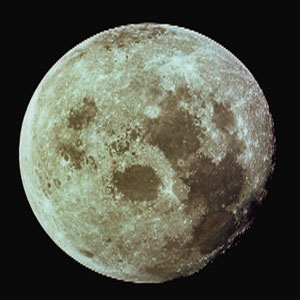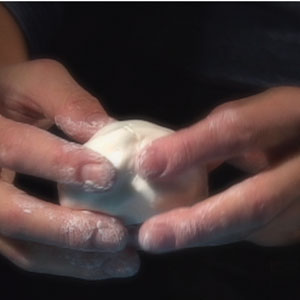Join us for conversations that inspire, recognize, and encourage innovation and best practices in the education profession.
Available on Apple Podcasts, Spotify, Google Podcasts, and more.
Look for the following topics in the video, indicated by the ![]() onscreen icon, and click below to learn more.
onscreen icon, and click below to learn more.
|
 In the video we define matter as “having weight and taking up space.” Certainly the Moon seems to take up space — it appears in the sky every night, sometimes blocking our view of the stars, other planets, and even the sun during an eclipse. But how do we know that it has weight?
In the video we define matter as “having weight and taking up space.” Certainly the Moon seems to take up space — it appears in the sky every night, sometimes blocking our view of the stars, other planets, and even the sun during an eclipse. But how do we know that it has weight?
In the video, we define weight as the measurement of the Earth’s pull on a particular piece of matter. To be more precise, in physics the measure of the amount of stuff in matter is called its mass, which is a quantity independent of whether the matter is on Earth or not. Anything that has mass exerts a pull, or the force we call “gravity,” on other things that have mass. On Earth, we call the measurement of this pull on a particular piece of matter weight.
Since antiquity people have observed the moon reliably in the sky, never seeming to fly out of its orbit. This fact provides a clue that there might be some pulling going on. Newton’s third law — for every action, there is an equal and opposite reaction — describes the relationship. If the Earth is pulling the Moon, the Moon is also pulling on the Earth with an equal force and in the opposite direction. So, if the Earth is pulling on the Moon, and the Moon is also pulling back on the Earth, then they both have mass and both take up space, and so by definition are made of matter.
You may remember that during the Apollo missions in the 1970s, the Command and Service Module, with one astronaut remaining on board, was in orbit around the Moon for a couple of Earth days. By carefully recording the motion of the CSM as it passed close to the Moon, it was possible to determine the strength of the Moon’s pull on the CSM, which results from its mass. This is the closest we can come to actually weighing the Moon!
It turns out that the Moon contains about 1/80 of the mass of the Earth. If we scale the weight of the Earth to that of an elephant (11,000 pounds), the Moon would weigh as much as the average person (about 140 pounds). Interestingly, the Moon’s matter is almost all solid, with just a small amount of carbon and hydrogen gases, and no liquid.
 The mystery substance that Chris Bash’s class investigates in the video is a variation on what is also sometimes called “oobleck,” after the Dr. Seuss’ book Bartholomew and the Oobleck. It is made up of tiny particles of liquid starch and glue suspended in water. Chemists call this type of mixture a colloid. As Chris’s students discover, this colloid behaves strangely. They describe it as sticky, egg-like, slimy, stringy, droopy, and marshmallow-like. And, as our hosts Sallie and Robin point out, it has properties of both a solid and a liquid. It “holds together” if pressed into a ball, but when left alone, it will take on the shape of its container. Another interesting feature of the mystery substance is that if you try to stir it slowly, it flows easily, like a liquid. However, if you try to stir it quickly or strike it sharply, it resists strongly, like a solid.
The mystery substance that Chris Bash’s class investigates in the video is a variation on what is also sometimes called “oobleck,” after the Dr. Seuss’ book Bartholomew and the Oobleck. It is made up of tiny particles of liquid starch and glue suspended in water. Chemists call this type of mixture a colloid. As Chris’s students discover, this colloid behaves strangely. They describe it as sticky, egg-like, slimy, stringy, droopy, and marshmallow-like. And, as our hosts Sallie and Robin point out, it has properties of both a solid and a liquid. It “holds together” if pressed into a ball, but when left alone, it will take on the shape of its container. Another interesting feature of the mystery substance is that if you try to stir it slowly, it flows easily, like a liquid. However, if you try to stir it quickly or strike it sharply, it resists strongly, like a solid.
When you stir a liquid, you are applying what a physicist would call a sideways shearing force to the liquid. In response, the liquid shears, or moves out of the way. The behavior of the mystery substance relates to its viscosity, or resistance to flow. Water’s viscosity doesn’t change when you apply a shearing force — but the viscosity of the mystery substance does. Back in the 1700s, Isaac Newton identified the properties of an “ideal” liquid as having a having a consistent viscosity, or resistance to flow, at any given temperature. Water and other liquids that have the properties that Newton identified are called Newtonian fluids. The mystery substance doesn’t act like Newton’s ideal fluid, and is therefore called a non-Newtonian fluid.
There are many non-Newtonian fluids. They don’t all behave like the mystery substance, and each one is unique in its own way. Ketchup, for example, is a non-Newtonian fluid. Quicksand is a non-Newtonian fluid that acts more like the mystery substance — it gets more viscous when you apply a shearing force. If you ever find yourself sinking in a pool of quicksand (or a vat of cornstarch), try swimming toward the shore very slowly. The slower you move, the less the quicksand or cornstarch will resist your movement.